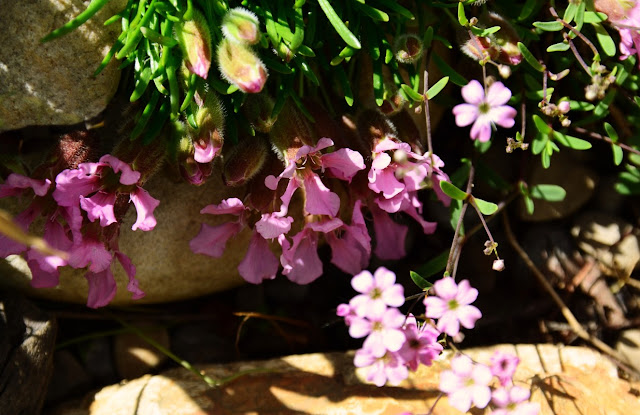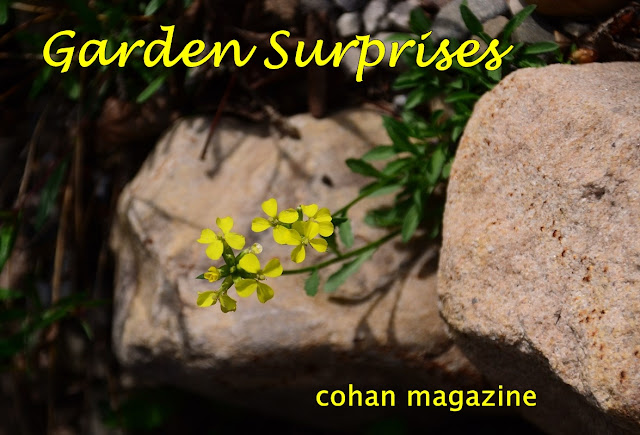A few years ago, I sowed seed of a couple of species of
small Erysimum / Wallflowers -- plants in the Mustard family, with some larger,
showy relatives popular in gardens. (The name Wallflower refers to the habit of
some species of growing in stone walls, think Britain). I planted out a number
of seedlings in several spots, but, as usual, had fewer tags than seedlings--
the expectation is that as the plants grow, I can refer to those with tags to
id those without. The problem with that strategy is that not all
seedlings survive, and not necessarily those with tags-- you can see where
that might lead to confusion...
In this case, I remembered planting the Erysimums in a
particular bed in which none survived, and I thought that was that. A couple of
years later, in a very different bed far removed from that spot, a little clump
which I'd been thinking was one of the Dianthus or Silenes I'd planted,
flowered for the first time, and was, in fact, a mustardy thing I had no memory
of planting there. I eventually realised it must be one of those Erysimums.
Here again we see the value of planting multiple seedlings in multiple
spots--which will survive and where is not always readily knowable!
Unfortunately, that plant has been susceptible to flea beetles in spring, as
many Brassicaceae are here, which damage flowers and foliage. This year I was
able to reduce the impact by hosing off the insects a couple of times, and
a rainy spring may have helped, so it was able to make a bit of a show, set off
by a luckily located self sown Viola elegantula, though you can still see some of the beetles in the photo!
 |
| Erysimum sp / Wallflower with Viola elegantula, Rhodiola rosea etc in the rock garden |
This year, another little presumed Erysimum showed up, in
a bed adjacent to the one where none survived-- it's in a good spot, where it
can trail down between the stones in what is nearly a rock wall. This one does
not seem to have been noticed by the flea beetles yet, knock on wood!. I dug
out my old sowing lists to search for names, and combined with some online
image searching—I’m not sure! The candidates are E. pulchellum and E. kotschyanum.
the distinctions are fairly modest one should have slightly longer stems, there
may be differences in leaf shape, but I haven’t found descriptions/photos which
make me confident to make a decision based on the photos I have. Better photos,
more careful reading and/or an experienced eye may tell!
Then we have another sort of garden surprise. Several years
ago, I planted out a number of alpine seedlings, including some Dianthus and
Silene species, several of which began flowering over the last couple of
seasons and are thriving, a couple others doing less well, and/or still
awaiting first flowering. Of course I don’t remember all the spots I placed
various seedlings, and they don’t flower at the same time in all beds. Recently
I was noticing first flowering on a Silene which started last year in some
other spots-- S. maritima or similar, with white flowers, inflated
bladder calyces-- and then noticed a stray pink flower. First thought was that
it was a fallen flower, darkened in senescence, but I realised it was still
attached, and then I realised it was a different plant, which in fact had lots
of those pink flowers in a ring around a low mound of foliage. This was a
surprise, since I did not remember planting any Silenes that should flower
pink. I looked around other beds to see if there were any more of these -- no
sign so far, not even matching mounds of foliage that I’ve located so far (if
you’d seen my gardens in person, you’d understand why I’m not making any
definitive statements). So, off to the seedlists to see which Silene I’d
forgotten sowing -- nothing matching found. The possibility still exists that
it’s on a seedlist I didn’t look at (eg, someone I only got a few things from,
and didn’t think to check for this) but my main theory at the moment is that it
was a stray seed from another species that got mixed in with something else I
sowed. I’ll be asking around to see if anyone knows what it is, and seeing if
it makes seed, so I can plant some in better spots (it’s in kind of a low
section of Semp Bed Two, surrounded by slightly taller plants, it deserves a
rocky ridge where it can be seen better).
 |
| Silene species, growing with its cousins in the Carnation Family, Gypsophila and Saponaria |
 |
| Mystery Silene with Gypsophila repens / Alpine or Creeping Baby's Breath |
 |
| Mystery Silene-- large good pink flowers, low mound of foliage; with Gypsophila |


Comments
Post a Comment